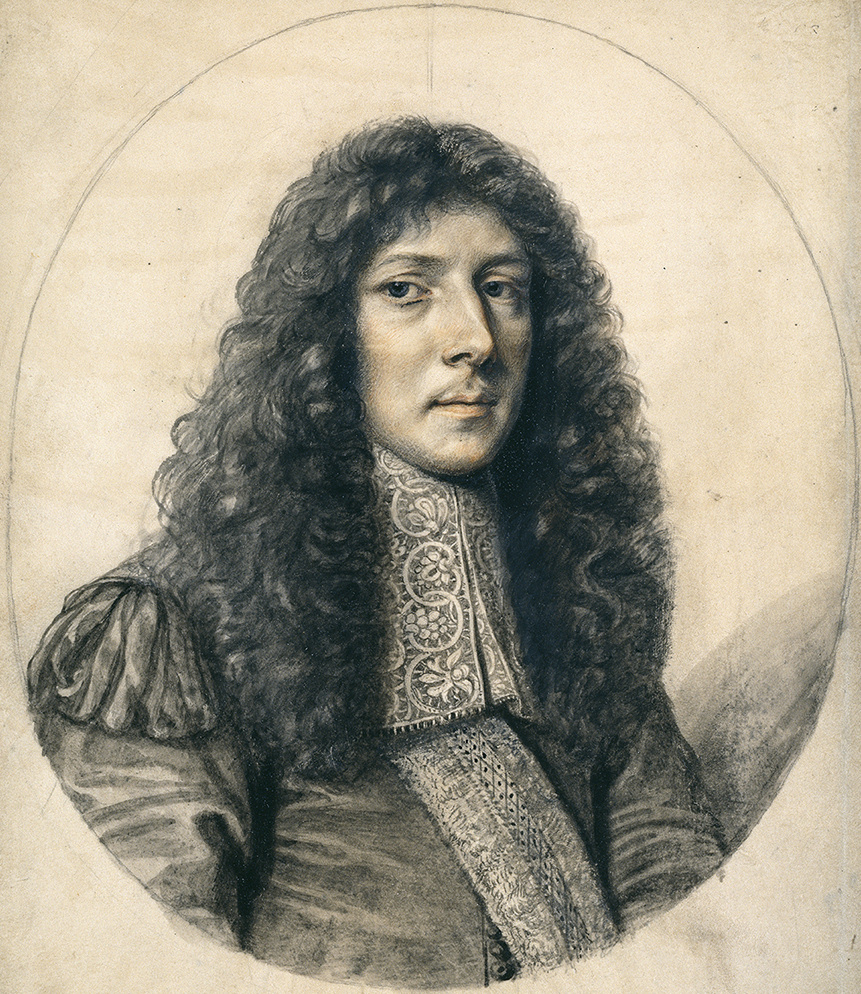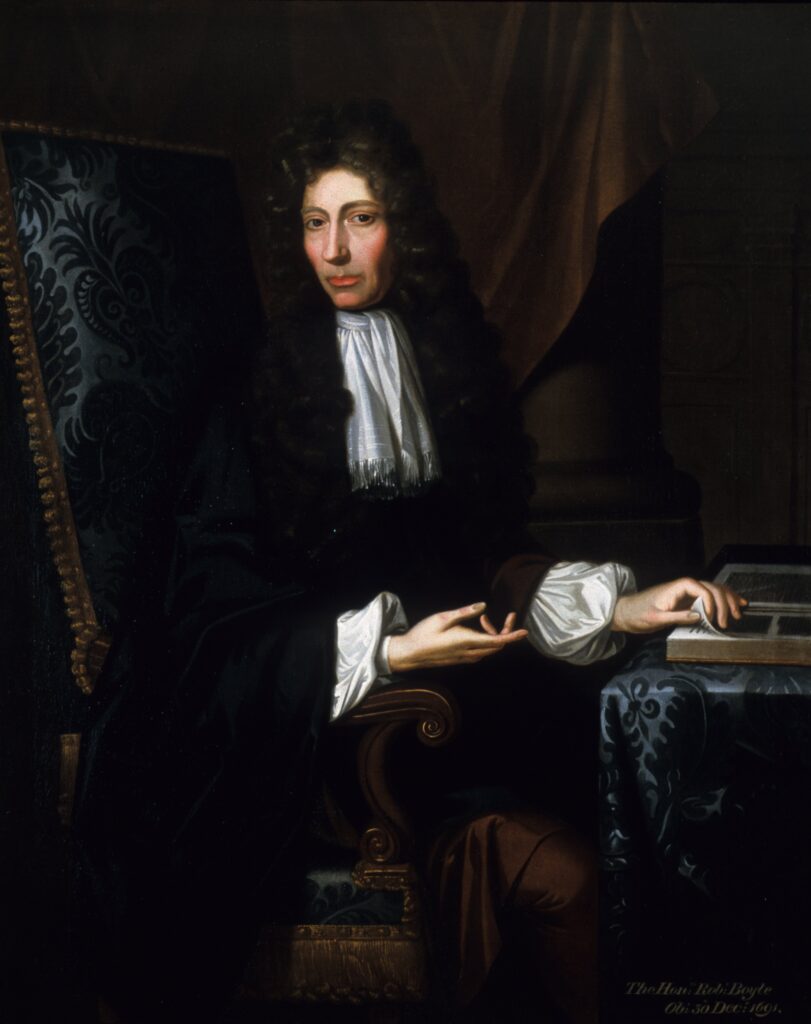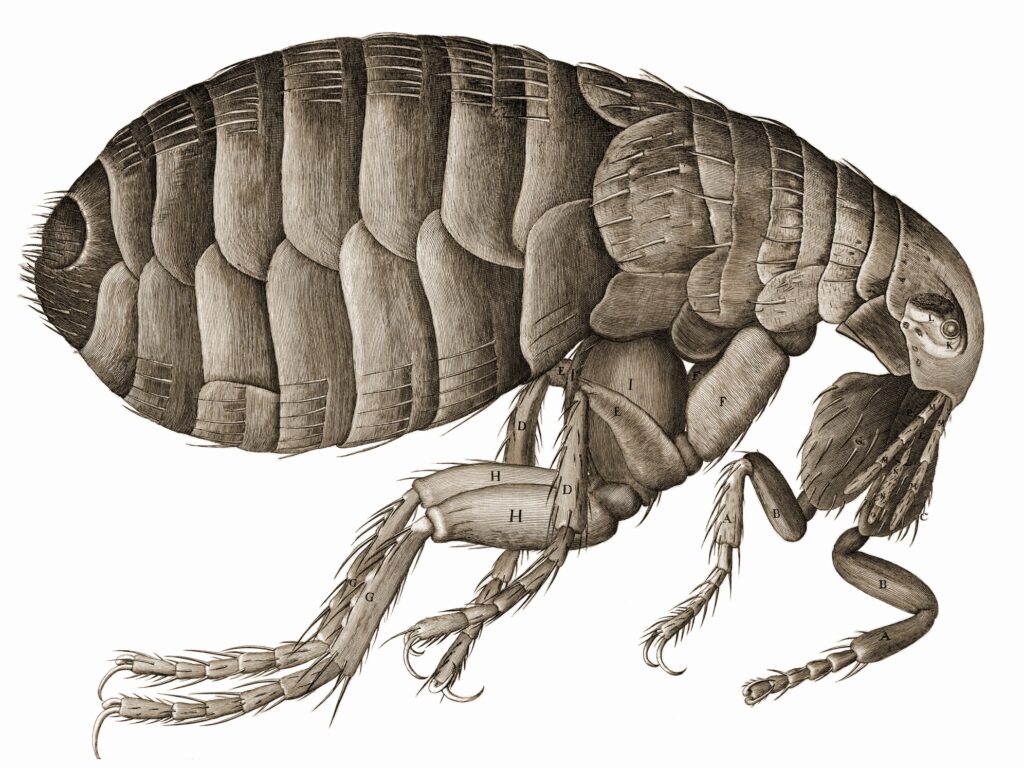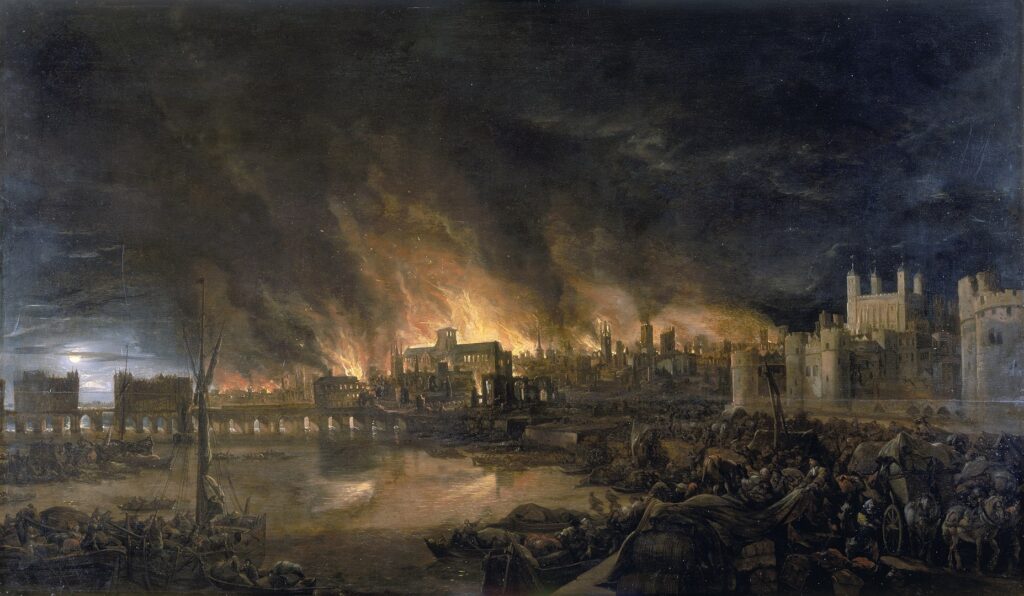Without a doubt, Robert Hooke was one of the greatest minds in British history. His scientific contributions spanned physics, astronomy, horology, microscopy, paleontology, and even architecture. And yet, he is nowhere near as well-known today as his peers.
The Royal Society believes that Hooke’s scientific career can be split into three parts. First were the early years when Hooke had the inquisitive mind and the ambitions necessary to become a great scientist. Then came the apex of his profession around the time of the Great Fire of London in 1666. His architectural work redesigning and reconstructing many buildings devastated by the fire brought him great wealth. And, lastly, there is the third stage of Hooke’s life where bitterness and rivalries with other scientists overshadowed his contributions and ensured that he became a footnote of history.
But Robert Hooke wasn’t forgotten completely and today we take a look at the man sometimes described as the “Leonardo da Vinci of England.”
Early Life
Robert Hooke was born on July 28 (or July 18, going by the Old Style British calendar), 1635, in the village of Freshwater on the Isle of Wight, the youngest of four children to John Hooke and Cecily Gyles. For the first part of his life, Hooke was a frail and weak child and his parents had little hope that he would survive. Even so, his father took the time to provide him with an education. John Hooke was a priest with the Church of England at Freshwater’s Church of All Saints. He had two or three brothers who were also ministers and expected young Robert to follow in their footsteps.
From an early age, Robert Hooke showed his family that he had other interests. He was fascinated with mechanical devices and toys and enjoyed taking them apart and putting them back together again. Still a child, Hooke built a ship about a yard long which had proper rigging and could sail and even had some small guns that would fire. On another occasion, he completely disassembled an old brass clock to see how it worked and created a functioning replica out of wood.

Also during childhood, Hooke picked up another interest that would serve him well in life – drawing. The story comes to us courtesy of the book Brief Lives by 17th century writer and natural philosopher John Aubrey, one of the main sources for Hooke’s early years. A painter named John Hoskyns came to Freshwater to draw pictures for an unspecified nobleman. Young Hooke saw him in action and wanted to give it a shot. He did not have the right supplies so he had to improvise. Robert collected chalk, coal, and a red pigment called ruddle, ground them together and placed the mixture on a wooden platter. He then took a pencil and began copying the pictures that the family had around the house.
Education
Even though it became clear that Robert would not go down the path of the church like his father and uncles, John Hooke still wanted to ensure that his son had the means to pursue his profession of choice. When John Hooke died in 1648, he left Robert an inheritance of either forty or one hundred pounds, depending on the source, so he could secure an apprenticeship.
At first, it seemed like Hooke was destined to be an artist. He became an apprentice to Sir Peter Lely, a Dutch painter who was one of the premiere portraitists of his time. He also studied with Samuel Cowper, a man described by Aubrey as the “prince of limners of this age.” A limner was someone who illuminated manuscripts i.e. decorated them with drawings, borders, and initials.

Hooke’s foray into the art world did not last long. He discovered that the smell of oil colors exacerbated the headaches that he suffered from since childhood so, instead, he enrolled at the Westminster School in London under headmaster Richard Busby. Here, Hooke learned Latin and Greek and got his first taste of geometry.
Early Years at Oxford
Always looking to expand his horizons, Hooke also took an interest in music and had twenty lessons on the organ. This was enough to secure him a spot as a chorister at Christ Church College in Oxford around 1653. There, he came under the influence of some of the most accomplished scientists of that era: Robert Boyle, Dr Thomas Willis, John Wilkins, Christopher Wren. Eventually, he enrolled to study at Wadham College. Hooke himself later described these Oxford days as the period of his life which cemented his love of science.

We do have limited knowledge of Hooke’s scientific contributions during these early stages. He served as a chemistry assistant, first to Willis and then to Boyle. According to his journal, Hooke designed and built an air pump which Boyle used in his experiments with the pneumatic engine. He also came up with a variety of designs which are lost to history regarding “the art of flying.” He presented these to John Wilkins who found them impractical, but ingenious.
Hooke’s most significant invention at this time, though, had to be the anchor escapement. This was a small cog fitted to pendulum clocks which helped maintain the swing and made the clock more accurate by giving a small push with each swing. Hooke continued his studies of timepieces as the years went on and, around 1660, also created the balance spring for pocket watches. It should be mentioned, though, that some believe that credit for this invention is due to Dutch scientist Christiaan Huygens.
At the same time, some historians argue that Hooke deserves partial recognition for Boyle’s Law, an experimental gas law described and named by his employer at the time, Robert Boyle. The reasoning behind this is that Hooke designed and built most of the apparatus used in Boyle’s experiments.
The Curator of Experiments at the Royal Society
Something important happened in 1660 – the Royal Society was born. One of the oldest learned societies still in existence today, it eventually became the first national scientific society in the world.
Unofficially, it existed for a couple of decades prior to it becoming a formal organization and receiving a royal charter from King Charles II. Initially, it consisted of various scientists who got together to discuss ideas and experiments. Most were part of the Gresham College group who, as the name implies, met at Gresham College in London. Eventually, twelve of these scholars formed a committee and founded the Royal Society of London for Improving Natural Knowledge. This was a bit of a mouthful, though, so, by the time the king granted them their charter in 1662, they were already known simply as the Royal Society with William Brouncker serving as their first president.
Now, Robert Hooke was not among the original twelve founders, but some of his friends and mentors were such as Robert Boyle, Christopher Wren, and John Wilkins. Therefore, it wasn’t surprising that Hooke was among the first new additions to the club. In November 1662, he became Curator of Experiments at the Royal Society.
This was described as a position that only Hooke could fill as he was required to demonstrate three or four experiments at every meeting and, at first, he wasn’t even paid to do it. Yet Hooke acquitted himself marvelously of his duties as he finally had a scientific outlet for all the ideas he accrued over the years and, as an audience, he had his most brilliant peers who were in the best position to judge and appreciate his work.
Hooke’s contributions were one of the main reasons why the society flourished during its early stages. Consequently, he was appointed Curator for life and, also, was granted another position of Cutlerian Lecturer in the Mechanical Arts so he may receive another salary from funds provided by Sir John Cutler. And if this didn’t keep Hooke busy enough, in 1665 he also became the Professor of Geometry at Gresham College.
Micrographia
Among the many accolades, we can ascribe to Robert Hooke, we can add the popularization of microscopes to the list. In 1665, he published the first major work in history on microscopy titled Micrographia or, to give it its original, full name, Micrographia: or Some Physiological Descriptions of Minute Bodies Made by Magnifying Glasses. With Observations and Inquiries Thereupon.
Even though the title was a tad long-winded, the book was a hit. It showed the world that Robert Hooke was one of the preeminent scholars of his time and it also helped solidify the status of the Royal Society as this was its first major publication. The politician and famed diarist Samuel Pepys labeled Micrographia “the most ingenious book that ever I read in my life.”

Inside the book, people could see for the first time close-up, detailed drawings of insects and plants which were done by Hooke himself, therefore giving us a glimpse at his skill as an artist, as well. The images were accompanied by insightful, somewhat artful descriptions. Hooke’s most famous illustration, the flea, for example, was described as being a “little busie Creature…adorn’d with a curiously polish’d suit of sable Armour…and multitudes of sharp pinns, shap’d almost like Porcupine’s Quills.”
Some entries were peppered with humor such as the instance where Hooke described how he got an ant drunk so that it may sit still and allowed to be examined. The scientist claimed he gave the insect brandy which “knock’d him down dead drunk, so that he became moveless”, only to revive and run away after about an hour. It wouldn’t be completely out of the question to regard Hooke and his Micrographia as a science popularizer, trying to bring knowledge to the masses a few centuries before his time.
The microscope used for these examinations was notable in of itself. Hooke did not build it. He outsourced this task to a famed London instrument maker named Christopher Cock. Hooke did modify and refine it, though, by attaching a screw-operated focusing mechanism of his own design, as well as adding a water lens which could aim a bright pinpoint of light on the smallest of targets.
Another thing worthy of mention in Micrographia was the first use of the biological term “cell” which denoted the basic structure which all organisms are made out of. Hooke coined the word while looking at a piece of bark from a cork tree under his microscope. He described it as being “perforated and porous, much like a honeycomb.” It was made out of little boxes which Hooke called “cells” because they reminded him of the rooms of monks inside a monastery.
Micrographia was a perfect example of how Hooke’s mind worked. He was a man of many interests and he developed them all at the same time. He wasn’t one to focus his attention on just one thing. Even though the book was intended as a presentation of microscopy, it also described distant planetary bodies which Hooke observed with his telescope. It also presented his examination of fossilized wood and Hooke’s associated ideas which resembled an early version of the . He also talked about the wave theory of light and other scientific interests which had nothing to do with the original purpose of Micrographia.
Hooke also mentioned his ideas on combustion. At a time when other scientists were adopting the theory of phlogiston, a fire-like component which they thought existed in combustible elements, Hooke opined that the process was determined by a substance which was mixed with air. Although this is pure speculation, some modern scholars believe that, if Hooke had pursued this line of inquiry more fervently, he would have discovered oxygen a hundred years earlier.

Robert Hooke, Architect
Although Hooke was, undoubtedly, a scientist, he actually made more money in his lifetime from his side job as an architect.
On September 2, 1666, London was ravaged by a great fire which burned down most of the medieval part of the city. The blaze lasted for five days and consumed over 13,000 structures, most of them houses. Afterwards came the monumental task of rebuilding the city.
The duty (and the ensuing accolades) fell on Christopher Wren, someone who is literally remembered as “the man who rebuilt London.” This is not without merit. Wren oversaw the construction of many important buildings and structures. He designed 52 new churches, including his magnum opus, St. Paul’s Cathedral.
Wren was aided in his endeavor by Robert Hooke who served as his chief assistant and the new Surveyor to the City of London. But while Wren’s name is now inexorably tied to the architectural landscape of London, Hooke’s contributions are seldom remembered even though he surveilled and certified nearly 3,000 new foundations between 1667 and 1672.
In his own time, John Aubrey gave Hooke credit for building the Royal College of Physicians, Bethlem Royal Hospital, and Montagu House, among others. Even he did not know the full extent of Hooke’s input, merely noting that Hooke was “much made use of” when it came to designing new structures.
It is hard to say with any certainty what the dynamic was between the partnership of Wren and Hooke. Some modern historians even argue that Hooke was the more important partner because it was his expertise in mechanics which made many of the new buildings possible. We will probably never know for certain the extent of the influence that Hooke had on the landscape of London.
Hooke’s Law
Hooke’s lasting contribution to physics is the law of elasticity that shares his name. Hooke’s Law states that the force needed to compress or extend a spring by some distance is proportional to that distance. The formula for this principle is F=-kX, where F is the force applied to the spring, X is the distance the spring compresses or expands and k is the spring constant which denotes its stiffness. The formula is typically presented with a negative value to show that the force exerted by the spring opposes its displacement.
What might be more interesting to us, however, was the way in which Hooke presented his new principle. We are not exactly sure when Hooke first came up with it. He had made claims about developing it as far back as 1660, but he published it in 1678. Two years prior, however, he gave everyone a teaser in another book of his titled Descriptions of Helioscopes. He listed ten new discoveries and inventions which he intended to present in the near future. One of them was “The true Theory of Elasticity or Springiness, and a particular Explication thereof in several Subjects in which it is to be found: And the way of computing the velocity of Bodies moved by them. ceiiinosssttuv.”
That last bit was not a typo, by the way, it was an anagram. Two years later, he revealed that it meant “Ut tensio, sic vis” which was Latin for “as the extension, so the force.” You might consider it a bit odd that Hooke went to such lengths, but it was not completely unheard of in those days to conceal your workings behind anagrams, cyphers, or some other kind of hidden message.
The idea was that, by publicly presenting a theory in this way, the scientist established priority without revealing too much information. Afterwards, they were free to keep working on their project for months, years, even decades, until it was fully fleshed out and ready to present to the world. If, in the meantime, another researcher unveiled the same idea, the initial scientist had proof that they started work on the subject first.
There are quite a few important discoveries and inventions whose originators are under doubt because multiple scientists worked on them at the same time. Hence, Hooke’s use of the anagram, a strategy that had been employed by other prominent scientists such as Newton, Galileo, or Huygens.
A Rivalry with Newton
As you can see, Robert Hooke was incredibly accomplished, yet he enjoys only a fraction of the renown of his great contemporaries. But why is that? You know the old saying “history is written by the victor?” In this case, it could simply be that Hooke picked a fight with the wrong guy.

Setting aside Hooke’s many talents, it is important to remember that he was still a man full of foibles. It seems that he was particularly prickly when he perceived that others tried to take credit for something he came up with. The problem was that Hooke often moved on from one idea to another if he did not perceive it to be important enough or something he could use to patent and profit. This meant that a lot of his notions were undeveloped and never advanced past the stage of scribbles on a piece of paper. It would be a little like crediting da Vinci with the flying machine because he made a drawing of one.
Unsurprisingly, this attitude led to several feuds with fellow scholars. We already mentioned in passing that he and Christiaan Huygens argued over who developed a spring for watches first. He also quarreled with a German theologian and scientist named Henry Oldenburg. But Hooke’s greatest rivalry, one that had a profound effect on his reputation, was with Isaac Newton.
The relationship between the two turned sour in 1672 when Newton presented his notions on light and color. Hooke insisted that Newton’s work was based on ideas of his which he developed in 1665. This quarrel was only the appetizer, though, as the main course came in 1687 when Isaac Newton published Philosophiae Naturalis Principia Mathematica or, simply, the Principia, arguably the most famous book in the history of science.
Among other seminal principles, the Principia contained Newton’s law of universal gravitation, an inverse square law that showed how planetary motion worked. It was a landmark moment in physics, but Hooke accused Newton of plagiarism.
It is actually pretty hard to establish how much credit, if any, should go to Hooke. By Newton’s own admission, he corresponded with Hooke on the matter, but he maintained that the latter never provided any new information. He might have concluded that an inverse square law governed the motion of the planets, but he never produced any proof for it even though he claimed to have it. This point of view was corroborated by Edmond Halley, another esteemed scientist known today for Halley’s Comet. He said that he asked for proof from both Hooke and Newton, but only the latter delivered. Halley later encouraged Newton to write the Principia and financed its publication out of his own pocket.
French astronomer Alexis Clairaut was more tactful when dismissing Hooke’s claims, saying that they showed us “what a distance there is between a truth that is glimpsed and a truth that is demonstrated.”
What Did Hooke Look Like?
Hooke’s rivalry with Newton had a negative effect on his image, as well as his standing in the scientific world. Some of his later lectures reveal that he never conceded the point that he came up with the inverse square law first. In one of those lectures, he said “…concerning those properties of gravity which I myself first discovered and showed to this Society and years since, which of late Mr Newton has done me the favour to print and publish as his own inventions.”
Hooke gained a reputation of being bitter and disgruntled. He died in 1703 of an unspecified illness and was buried at St Helen’s Bishopsgate, although the exact location is unknown. Soon afterwards, another Royal Society member named Richard Waller published a collection of Hooke’s posthumous works and included a short biography where he described him as being “melancholy, mistrustful, and jealous.” This biography, the only one from a contemporary, influenced all those that followed, but we do not know the relationship between Hooke and Waller.
As for Newton, he became President of the Royal Society the same year that Hooke died and it is said that he took steps to ensure that the world would forget his former rival. This may have included the destruction of the only known portrait of Robert Hooke so that even his likeness would be lost to history. But before we go on besmirching Newton’s good name, we should stress that there is no solid evidence that he ever did this or even that the portrait existed in the first place other than a few mentions. Some have speculated that Hooke never wanted to sit for a portrait because he had a weak and misshapen body due to his childhood illness.
Indeed, today we have no idea what he looked like. This is the most famous representation of Hooke based on the few available descriptions, but you might be surprised to learn that this painting, done by Rita Greer, is only 15 years old. She is one of the people who, in recent years, have undertaken efforts to restore Robert Hooke to his rightful place in the pantheon of Britain’s greatest scholars.



